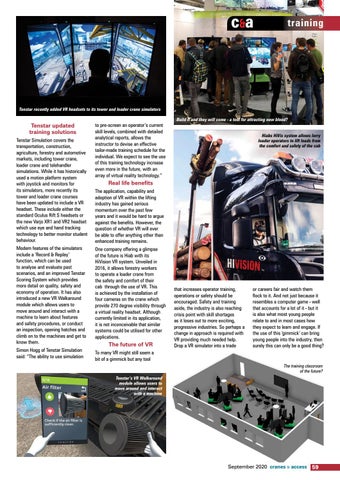c&a
training
Tenstar recently added VR headsets to its tower and loader crane simulators
Tenstar updated training solutions Tenstar Simulation covers the transportation, construction, agriculture, forestry and automotive markets, including tower crane, loader crane and telehandler simulations. While it has historically used a motion platform system with joystick and monitors for its simulators, more recently its tower and loader crane courses have been updated to include a VR headset. These include either the standard Oculus Rift S headsets or the new Varjo XR1 and VR2 headset which use eye and hand tracking technology to better monitor student behaviour. Modern features of the simulators include a ‘Record & Replay’ function, which can be used to analyse and evaluate past scenarios, and an improved Tenstar Scoring System which provides more detail on quality, safety and economy of operation. It has also introduced a new VR Walkaround module which allows users to move around and interact with a machine to learn about features and safety procedures, or conduct an inspection, opening hatches and climb on to the machines and get to know them. Simon Hogg of Tenstar Simulation said: “The ability to use simulation
to pre-screen an operator’s current skill levels, combined with detailed analytical reports, allows the instructor to devise an effective tailor-made training schedule for the individual. We expect to see the use of this training technology increase even more in the future, with an array of virtual reality technology.”
Build it and they will come - a tool for attracting new blood? Hiabs HiVis system allows lorry loader operators to lift loads from the comfort and safety of the cab
Real life benefits The application, capability and adoption of VR within the lifting industry has gained serious momentum over the past few years and it would be hard to argue against the benefits. However, the question of whether VR will ever be able to offer anything other than enhanced training remains. One company offering a glimpse of the future is Hiab with its HiVision VR system. Unveiled in 2016, it allows forestry workers to operate a loader crane from the safety and comfort of their cab through the use of VR. This is achieved by the installation of four cameras on the crane which provide 270 degree visibility through a virtual reality headset. Although currently limited in its application, it is not inconceivable that similar systems could be utilised for other applications.
The future of VR
that increases operator training, operations or safety should be encouraged. Safety and training aside, the industry is also reaching crisis point with skill shortages as it loses out to more exciting, progressive industries. So perhaps a change in approach is required with VR providing much needed help. Drop a VR simulator into a trade
or careers fair and watch them flock to it. And not just because it resembles a computer game - well that accounts for a lot of it - but it is also what most young people relate to and in most cases how they expect to learn and engage. If the use of this ‘gimmick’ can bring young people into the industry, then surely this can only be a good thing?
To many VR might still seem a bit of a gimmick but any tool The training classroom of the future? Tenstar’s VR Walkaround module allows users to move around and interact with a machine
September 2020 cranes & access
59 55 41
